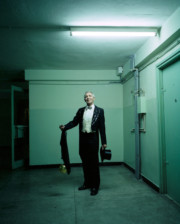Murmurings of the Skin
Olivia Arthur’s new photobook is an ode to feeling comfortable in one’s own skin, exploring human bodies, machines, and the intersection between
In 2014, when she was pregnant with her first child, Olivia Arthur began to witness a curious change in behavior around her body. People would start coming up to her on the street and, unannounced, touch her belly — almost as if her body had all of a sudden become public property. “I had never thought that much about my body before. And now I’m not even sure it is really mine,” she writes in the introduction to her latest photobook, Murmurings of the Skin, published by Void. “It has become a machine, doing this incredible task of growing a human.”
Arthur’s new book looks at both human and machine, not in contrast with each other, but melded together into one lyrical examination of the body. From page to page, we see depictions of people and robots through gentle black-and-white portraits, images of natural and artificial body parts in close examination, moments of stillness, and moments of movement.
Inspired by the new-found curiosity in the human body, the images date back to 2015, following the birth of her daughter. “I found myself going on a journey to explore the relationship between our physicality and our emotions; the ways we touch each other, how we repair and enhance our bodies; and what the limits are,” she explains in the introduction. “But I keep coming back to the human, the animal that I became again when she was born.”
The birth of her daughter marked not only a shift in Arthur’s perspective but a shift in her practice. “I started to be curious about other people, how they feel about their bodies,” she explains now, as she flicks through a first edition of the new photobook in a video for WEX. “I was wondering why we have such a complicated relationship with it, so I started wanting to photograph it.”
She traveled back to India, where she had started her photographic career in 2003. There, she developed a series titled In Private/Mumbai, an intimate exploration of body, gender, and sexuality. For this series, Arthur shot mainly in people’s homes and bedrooms, where they could express themselves fully — far from the judging eyes of everyday society and boundaries of conformity and non-conformity in the country.
Arthur’s process was slow and purposeful. Changing her approach to work in 5×4, she was obliged to set up her box camera and tripod for each image, ducking underneath the dark sheet each time to get the shot. Working in large format is a slow, intimate, and deliberate process, one that obliges photographer and subject to really spend time with each other, and one in which the person being photographed knows what is going on. “You don’t grab a picture, you really work on it together, and I found it felt very honest to me,” she explains.
The change was what was needed to form a trusting bond between photographer and individual. It also helped Arthur fall back in love with the medium: “I feel like every time I do something new I change my approach a little bit, and fall back in love with photography again,” she says. The intimacy fostered by this format seeps through the pages of the book today. In one image from India, a young man stares frankly at the camera, perched on a pile of magazines. In another, her daughter Thea proudly shows off her double teeth.
"I feel like every time I do something new I change my approach a little bit, and fall back in love with photography again."
-
Applying the same approach to portraiture, the bodies in the book feature an array of people and span eight year’s of Arthur’s practice; wrestlers in Rome, a dancer in Hull, scenes from her family life at home, and Charlotte from her and Philip Ebeling’s series TiChan.
Opening up about her process, Arthur tells the story of the book’s cover image — a close-up of an individual’s hands from Rome in 2020. Originally a shoot with a woman and her grandson, Arthur recounts that as they were getting up to leave, she noticed the woman’s hands. “It represents something that happens to me quite a lot when I’m photographing,” she laughs. “We have a sitting, we talk about what we’re going to do, we make the picture. Then I pack up my camera and I’m sitting talking to them afterwards, and there’s quite often a moment where I see another picture, so I have to get the camera out and we do it all over again.” After the second shoot, focusing just on the hands, the woman whispered to Arthur: “You know, people fell in love with me because of my hands.”
“It’s kind of this amazing thing,” Arthur continues, “they’re incredibly beautiful, incredibly elegant hands, and the way she carries them…This picture is special.”
In 2020, Arthur gave a TED Talk on the “meditations on the intersection of humanity and technology.” Here, she explains her fascination with the subject, and how it overlaps with her exploration of the human body. “As humans evolve, along with technology, and the lines between the two become increasingly blurred, I set out to document our evolution into a new kind of human, and to play with that age-old question — can we ever see a real humanness in machines?”
As Arthur revealed images of the book in a conversation with Magnum colleague Gregory Halpern during Paris Photo, the audience gasped when Arthur pointed to a photograph of a newborn on the screen, and said that it was a robot, and not in fact human. Murmurings of the Skin blurs the lines between human and machine. Some images are quite clearly human-like robots, others are indistinguishable from humans, and the lack of accompanying captions sometimes leaves them deliberately ambiguous.
"I’m left in awe at the complexity of the human body. But I also feel that it’s not just our bodies, bionics or not, that make us strong, but our emotions, and understanding our weaknesses."
-
In one image, we see roboticist and engineer Hiroshi Ishiguro and his Geminoid robot, a near-perfect clone of his own being. In another, we see Ibuki, a child-like android, mimicking human facial expressions. “In those expressions, I saw a certain vulnerability that made him feel very real to me,” Arthur explains in the TED Talk. “When he was angry or sad, it resonated, and when he smiled, I wanted to smile back. I feel I was drawn to Ibuki as I might have been to a real child, and at the end of it all, I felt I wanted to thank him or reach out and shake his hand… seeing the vulnerability in Ibuki’s expressions seemed to make him more human to me.”
And particularly powerful are Arthur’s accounts of the people photographed combining both human and machine. Scattered throughout the pages are images of people proudly photographed with bionic limbs or robotic eyes. A portrait of Alex Lewis, a quadruple amputee, features with the accompanying caption “The strongest man I ever met.”
Lewis lost his limbs, and part of his face when he fell ill with Strep A. “He now has a chip in his arm to open his front door, a set of mechanical arms, and a handcycle to get around,” Arthur explains. “It’s been an incredibly tough journey, but the hardships that he’s faced have given Alex a superhuman ambition. He genuinely told me that his ordeal is the best thing that ever happened to him. He now goes on expeditions climbing mountains in Africa, he’s planning to cycle across Mongolia, and he works with London’s Imperial College, helping to develop a motorized hand.”
“I’m left in awe at the complexity of the human body. But I also feel that it’s not just our bodies, bionics or not, that make us strong, but our emotions, and understanding our weaknesses,” she concludes in her TED Talk. “But I’d like to think of these works as studies, something that we can come back to and carefully observe. A point in our evolution, before time runs away with us all.”
Four years after her TED talk, and Murmurings of the Skin provides just this — a moment to sit back, observe, and muse on our own relationships with the human body. “I like people to come away from my work feeling like they can touch it… feeling like they had an experience, that there’s a kind of sensation there, a touch sensation or a texture,” Arthur says. In many ways, the photographs are an ode to feeling comfortable in one’s own skin, a reminder not to take our bodies for granted, and through accounts such as Alex Lewis, proof of the sheer force that lies not within our physical strength, but within our emotions.
Pick up your copy of “Murmerings of the Skin” on the Magnum Photos Store.
Are you an aspiring or practicing photographer looking to develop your practice in portraiture? Olivia Arthur will be hosting a five-day workshop on the art of portraiture in May. More details here.






























